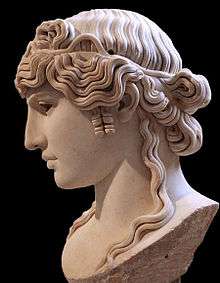Acrolith
An acrolith is a composite sculpture made of stone and other materials, as in the case of a figure whose clothed parts are made of wood, while the exposed flesh parts such as head, hands, and feet are made of marble. The wood was covered either by drapery or by gilding.[1][2] This type of statuary was common and widespread in Classical antiquity.

Greek etymology: acros and lithos, English translation: "height" or "extremity" and "stone".
Similarly, chryselephantine sculpture used ivory instead of marble, and often gold on parts of the body and ornaments. Acroliths are frequently mentioned by Pausanias (2nd century AD), the best known example being the Athene Areia ("Warlike Athena") of the Plataeans.[1]
Examples of acrolithic sculptures
- Athene Areia of the Plataeans
- Colossus of Constantine
- Antinous Mondragone
- Hera Farnese
- Augustus, dea Roma, Tiberius, Livia from Leptis Magna in Libya
gollark: Does YOUR computer have four (4) blinky LED lights on it?
gollark: No, but it does have a headphone jack, unlike some smartphones.
gollark: No.
gollark: * A55, not A75.
gollark: Also overengineered video decoding and a G610 GPU.
References
-

- Sturgis, Russell (1901). A Dictionary of Architecture and Building, Volume I. Macmillan. p. 23.
Secondary sources
- Barrett, Anthony A (2002). Livia,First Lady of Imperial Rome. Yale University Press. ISBN 978-0-300-10298-7.
External links

This article is issued from Wikipedia. The text is licensed under Creative Commons - Attribution - Sharealike. Additional terms may apply for the media files.